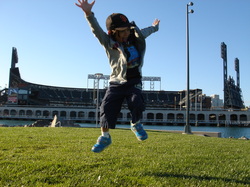
The Giants are in the World Series! Only the 4th appearance (1962, 1989, 2002 and 2010) by the team since moving to San Francisco from New York, over 50 years ago.
Is Baseball "Green"? Or at the least, how green is it?
I've thought about this a few times over the last few years, as we have heard about new stadiums going up that promote various green principles. But is baseball really green and how does it stack up to sepia baseball of yesteryear?
Years ago baseball used to draft players from their own protected regions, and players played for one team until they decided, or were forced to, retire. Of course, we all know about the free agency movement that has transformed sports and affected other aspects of society. Was the old draft greener than the modern one? Was baseball greener before free-agency? How about just stacking it up against other modern, multi-billion dollar industries?
As a whole, I would have to surmise that it is not greener now, because the MLB uses jets over long distances to get the players to parks in the far corners of the country. Chemicals are used on the grounds to keep them looking pristine. (One little known fact about the dirt at AT&T Park is that they use crushed up bricks to obtain the "International Orange" effect in the color; as this is the official color of the Golden Gate Bridge, too! Thus the "Orange" in the Team Colors, too.) Another reason is that teams played more local or regional games, since there were fewer teams to play against. -Even once the Giants and Dodgers moved out West, there were not as many teams and games played as there are in the game today.
Score Green points for the Old School!
However, the buses used today surely must be more energy efficient than the ones used "back in the day", when they do use them.
Score a Green point for the New School.
Let's take a better look at the whole picture, though. What areas can we look at? Well, how about:
-Transportation
-Stadiums
-Grounds & Grass
-Facility
-Player Health (Mentally & Physically)
-Equipment
-Foods
-League/Team Operations
-Energy Consumption
This is just going to be a simple observation on each area, as to research out the numbers would mean I need to get paid to do this, first! (LOL!)
So here we go!
First, TRANSPORTATION:
I would have to give the nod to New School, as modern buses are cleaner burning, as are newer planes. In fact many airlines are switching over their regional jets to more efficient turbo-props in order to see 30-40% increases in fuel economy, and lower pollution outputs. The cars that the players, managers, owners, fans and others drive to the games are much more efficient than the cars driven in the sepia era. Mass transit systems are better today.
Green Points: New School - 4, Old School - 2
Next, STADIUMS:
The materials used in older stadiums was most likely sourced more from local suppliers, as that was the way things were done. The advent of the global economy brought international suppliers to projects and local suppliers could not compete and went out of business. The local economy was sustained by sepia era ballpark construction. However, newer stadiums use recycled materials that old school parks would have never considered, nor could they have done so, in many cases. Some stadiums utilize low-flow toilets and there are some that use no-flow toilets that mean 10's of thousands of gallons of saved a season, per facility. Lighting is much more efficient and effective.
Green Points: New School - 4, Old School - 2
How about GROUNDS & GRASS:
While the field and grass is pretty much the same, the chemicals used today on some fields, and for the last 40-50 years has got to be a bad thing. However, I really wonder how they managed fields 60, 80 and 100+ years ago! I am willing to bet that they didn't have much in the way of weed killers to work with back then! Therefore, I would lean towards giving the Old school these points. The only thing that current grounds take into consideration is better water management, -maybe.
Green Points: Old School - 4, New School - 1
Then there's the FACILITY:
While the Old School parks have a sense of romance associated with the game, the facilities were not as sensitive to various fan needs, or to ballplayer's needs. The New School facilities are designed with so many more variables taken into account that there is almost no comparison. While Fenway Park attendees might beg to differ, I know "The 'Stick" (Candlestick Park, the Giants old stadium in S.F. that I grew up going to!) had much to desire. The only thing it had going for it were the memories made there for me, my family and the teams. (Like the time a pitcher was blown off the mound from a windy fog! I was there!)
Green Points: New School - 3, Old School - 1
Now let's not forget: PLAYER'S HEALTH:
Just like the last subject, I think this too is an apples to oranges comparison, -almost. While players are stronger, faster and maybe quicker, basic skills are lacking. Old School didn't have the Steroids problem we have dealt with for the last 30 years. Willie Mays take designer drugs to bulk and power up? UNTHINKABLE! -And we all know that didn't happen! Much as I love Barry Bonds, it just doesn't look good for his case. So while we DO have vitamins and training that definitely aids in player performance, we also have steroids hanging over the game. Therefore I must vent my frustration!
Green Points: New School - 1, Old School - 1 (All-Star Game Tie!)
Along with the players is their EQUIPMENT:
The New School has long had rumors of "Juice Ball", and then Maple Bats, better shoes, better performing uni's. The gloves are better made, as well. Better training equipment and better protection means safer play with fewer injuries. The only draw back the New School has had was "Astro-Turf", even though it was a truly "greener" solution, if we are strictly talking Nature. But, as in all things with life, "How does it perform?" is the question not many people ask. -Especially regarding buildings. (See other articles about Green Building below in this blog!) The Old school had some interesting objects to deal with, too! The rumor of the "Dead-ball" where hitters couldn't hit, and pitchers had the upper hand, literally, with a higher pitcher's mound, gave the old school some clout, too. Therefore, I have to give this one to the New School, but not by much.
Green Points: New School - 3, Old School - 2
Okay, next on deck is Food:
While food made available at the parks around the country has changed over the years,with the traditional treats being excluded, I'd have to say that the foods are worse today than in the Sepia Era. Why? The foods are all engineered with a lot of fats in them, and things like Nachos oozing with cheese all over them were just not part of the game, nor a regular diet when I was a kid. I know my dad and grandfather never had nachos at the old Tiger Stadium or the L.A. Colosseum. The first time I had some at a ballpark were at an A's game in Oakland, when I was in college. The foods come from the cheapest sources and from all over the world. Old School parks only had locally sourced items on the menu, for the most part; and most were not too highly processed neither. Plus, we didn't have to pay through the nose to get them, like we do for our current food concessions! 8 bucks for a big soda? Highway Robbery! To me, this is a 3-hit shutout! (Now, if we had certified organic consessions available at decent prices, it would be a race!)
Green Points: Old School - 3, New School - 0
Next, League/Team Operations:
While "things were simpler" in the Old School days, it definitely was not fairer to everyone else involved. Free Agency has seen to that, though. However, on all other issues, the business performs at a much better level then it did years ago. Years ago, even if you were a specimen to be reckoned with, you still might not have been in the Bigs. Nowadays, it's hard for anyone to not get found out all the way down in the high-school level. Sure this is largely attributed to the inter-connectivity in multi-media mass communications that make up our modern world. But, one must still USE it to take advantage of it. MLB definitely does that, as do all major sports in our great country. So this is a blow-out for the New School. How does this affect Green Points? The effective utilization of mass communication has lowered the amount of raw materials used to accomplish the same objectives. Could you imagine the mountain of paper it would have taken to do the same thing?
Green Points: New School - 5, Old School - 0
Last on my list we have Energy Consumption:
Of course, they used less energy at a game then they do now. Hand-run scoreboards, more day-games, smaller venues, fewer teams, fewer plane and bus trips, etc. So even though our New School game takes various energy saving precautions, the scale of the game is so much larger now, and the way the game interacts with the fans, viewers, and the community... -It's inevitable that they use more energy to bring us the national pastime. Something tells me that at smaller minor league venues there are opportunities for more passive solar lighting uses in the ballpark design, because the scale is smaller. I wonder if it is possible for minor league teams to also have more day games. Are they that dependent like their MLB big-show brothers on night game revenue that they can't adopt a more energy efficient game? The big league games, I am sure need the big lights to make good money for each club. However, the A through AAA teams might not need it as much, is my hunch. So I'm going to say the Old School used less energy, simply because of scale.
Green Points: Old School - 3, New School - 1
Certainly though, the modern game has some benefits over the old game. The players make more green money! A natural greening affect of the movement of players to the Yankees has kept money flowing to the other teams. (How about their total disregard for the salary cap?!!!)
So, let's tally up the score and see who wins the "Green World Series"!
(This was done in a a very old school, "9-game format"!!!)
Green Points: New School - 5, Old School - 3, Tie -1
While the New School Wins, the Old School did some things right, too. What do you think?

 RSS Feed
RSS Feed
